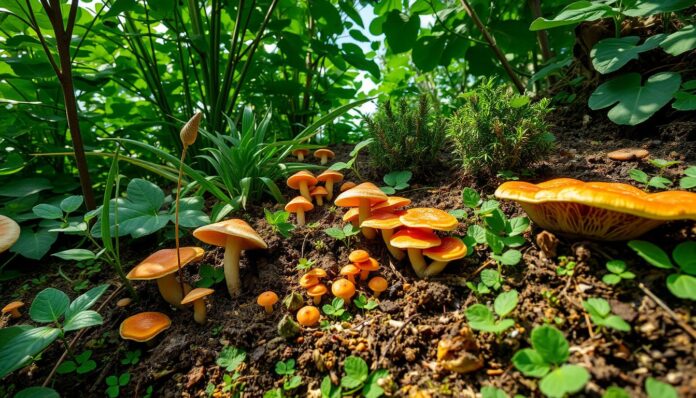What if the key to a thriving permaculture system lies in the often-overlooked world of fungi? Fungi play a vital role in permaculture. They are crucial for creating a sustainable ecosystem. With about 90% of plant species working with mycorrhizal fungi, it’s clear these organisms are key.
They help plants get nutrients and stay healthy. The benefits of permaculture fungi are many. They can increase plant growth, improve soil, and even fight pests naturally.
The role of fungi in permaculture is huge. They help with decomposition, nutrient cycling, and plant health. By understanding fungi’s benefits and how to use them, you can make your permaculture system better. So, how can you use fungi to improve your permaculture?
Key Takeaways
- Approximately 90% of plant species form symbiotic relationships with mycorrhizal fungi, enhancing nutrient uptake.
- Incorporating fungi in permaculture can lead to increased biomass productivity and improved soil nutrition.
- Permaculture fungal species can provide natural pest control and improve plant health.
- Mycorrhizal networks can connect multiple plants, allowing for nutrient sharing across species.
- The benefits of permaculture fungi include improved soil nutrition, increased biomass productivity, and enhanced plant health.
- Incorporating mycopermaculture can result in high yields and improved soil nutrition across various permaculture zones.
- Research indicates that many fungi have documented health benefits for humans, potentially offering natural antibiotics and immuno-enhancers.
Introduction to Fungal Species in Permaculture
Fungal species are key in permaculture, helping soil health and fertility. Mycorrhizal fungi in permaculture team up with plants, sharing nutrients and water for carbs. This partnership is vital for farming with fungi, boosting soil’s carbon and ecosystem strength.
The fungal network in permaculture is a vast web of mycelial strands. They break down organic matter, making nutrients for plants. By knowing fungi’s role, permaculture experts can build more diverse and strong systems. This uses fungi to improve soil health and fertility.
Importance of Fungi in Ecosystems
Fungi are diverse and crucial for ecosystems. They break down organic matter, release minerals, and team up with plants. This makes them vital for soil health and fertility.
Role in Soil Health and Fertility
Permaculture mycorrhizal fungi are key for soil health and fertility. They increase soil’s carbon storage and help nutrient cycling. By linking with plant roots, fungi boost nutrient uptake and plant growth.
Relationship with Plant Life
The bond between fungi and plants is complex and important. Fungi give plants nutrients and water, while plants offer fungi carbs and organic compounds. This mutual support is key for sustainable farming with fungi, fostering ecosystem resilience and biodiversity.
Identifying Key Fungal Species
Permaculture soil health is greatly influenced by various fungal species. Fungal diversity is key to a balanced ecosystem. Knowing the different fungi helps create a resilient and diverse permaculture. Fungi also act as bioindicators, showing the ecosystem’s health.
Several fungal species are crucial in permaculture. These include mycorrhizal, saprophytic, and endophytic fungi. Each fungus has a unique role, contributing to the system’s health.
Mycorrhizal Fungi
Mycorrhizal fungi form symbiotic relationships with plants. They provide essential nutrients and water. This fungus is vital for permaculture soil health, helping plants access more nutrients and water.
Saprophytic Fungi
Saprophytic fungi break down organic matter and recycle nutrients. They are important for maintaining fungal diversity in permaculture. This helps keep the ecosystem healthy.
Endophytic Fungi
Endophytic fungi live inside plant tissues. They protect plants from pests and diseases. This fungus is valuable in permaculture, enhancing plant health and resilience.
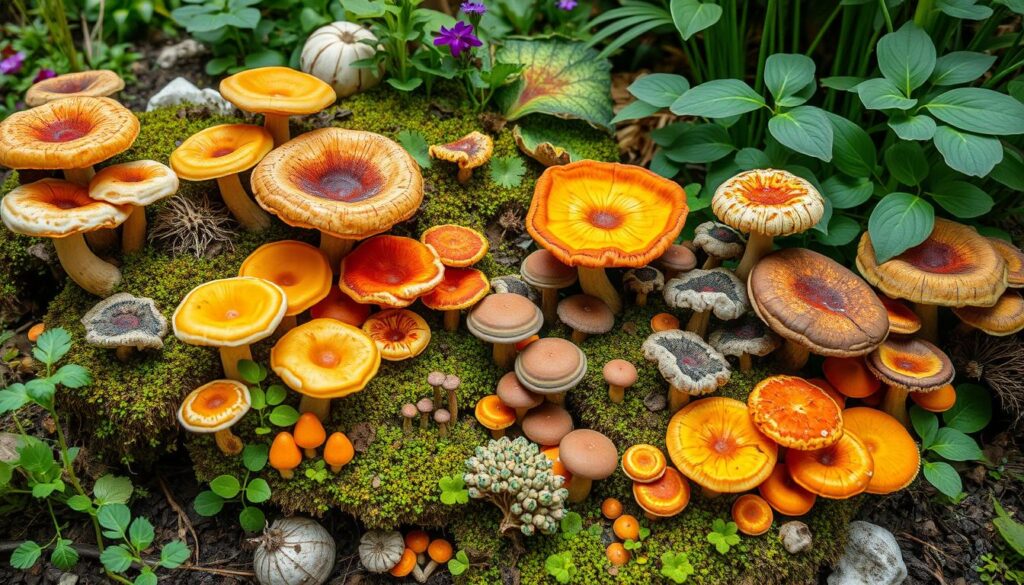
Understanding the roles of different fungal species is crucial. It helps create a diverse and resilient ecosystem. This supports permaculture soil health and the environment’s overall well-being.
| Type of Fungus | Function |
|---|---|
| Mycorrhizal Fungi | Form symbiotic relationships with plants, providing essential nutrients and water |
| Saprophytic Fungi | Break down organic matter and recycle nutrients |
| Endophytic Fungi | Live within plant tissues and provide protection against pests and diseases |
Mycorrhizal Fungi and their Benefits
Mycorrhizal fungi have worked with plants for about 450 million years. They form relationships that help plants grow better. By adding mycorrhizal fungi to permaculture, farmers can make their ecosystems stronger and improve soil health.
The benefits of mycorrhizal fungi include:
- Improved plant nutrition and water uptake
- Increased phosphorus absorption, which is essential for crop production
- Enhanced soil structure and aeration, promoting beneficial microorganism growth
Some key statistics show how important mycorrhizal fungi are in permaculture. For instance, endomycorrhizal fungi work with 70-90% of land plants. Mycorrhizal fungi in healthy ecosystems can almost double plant and herbivore productivity. By using permaculture fungi, farmers can make their food systems more sustainable and productive.
Mycorrhizal fungi are key in permaculture systems. They help improve soil health, plant growth, and ecosystem resilience. By using permaculture fungi, farmers can build a sustainable food system for the future.
| Benefits of Mycorrhizal Fungi | Description |
|---|---|
| Improved Plant Nutrition | Mycorrhizal fungi increase the uptake of essential nutrients, including phosphorus, nitrogen, and water. |
| Enhanced Soil Structure | Mycorrhizal fungi contribute to soil structure and aeration, promoting beneficial microorganism growth and improving soil health. |
Saprophytic Fungi in Nutrient Cycling
Saprophytic fungi are key in nutrient cycling. They break down organic matter and recycle nutrients. This is vital for sustainable farming with fungi, as it uses resources well and cuts down waste. In permaculture, these fungi help decompose organic matter, making nutrients available to plants.
In permaculture mycorrhizal fungi networks, saprophytic fungi team up with other microbes. This creates a strong ecosystem. The network helps nutrients move between plants, supporting their growth. By boosting soil microbial communities, saprophytic fungi improve soil health and fertility. This makes them a crucial part of permaculture fungal networks.
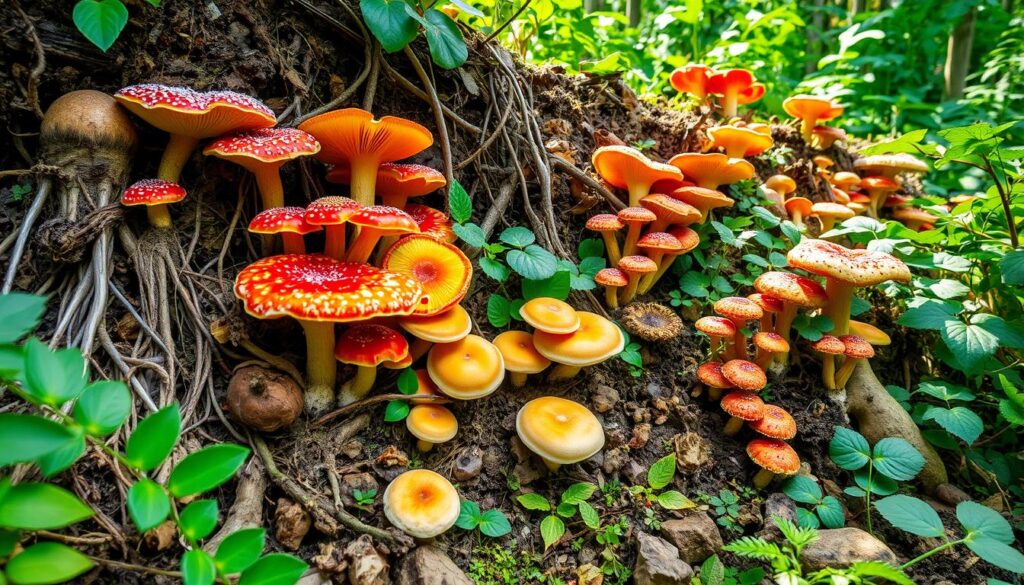
Examples of saprophytic fungi include oyster mushrooms and king stropharia mushrooms. These fungi grow on many substrates, from pasteurized corn stalks to paper by-products. This makes them great for permaculture systems. By using saprophytic fungi in sustainable farming, farmers can lessen their environmental impact and boost ecosystem health.
Key benefits of saprophytic fungi in nutrient cycling include:
- Breaking down organic matter and recycling nutrients
- Supporting soil microbial communities and improving soil health
- Enhancing plant growth and development through nutrient exchange
Endophytic Fungi and Plant Health
Endophytic fungi are key to keeping permaculture soil health strong. They live inside plants and help fight pests and diseases. This makes plants grow better and stronger.
These fungi can keep pests away, cutting their numbers by up to 70%. They also help break down tough organic matter. This makes nutrients easier for plants to use, boosting fungal diversity in permaculture. As fungi as bioindicators in permaculture, they help us check on soil health early.
- Improved plant protection against pests and diseases
- Enhanced nutrient absorption and plant growth
- Promotion of fungal diversity in permaculture and permaculture soil health
Using endophytic fungi, we can make permaculture systems better. They help keep soil healthy, support biodiversity, and balance ecosystems.
| Benefit | Description |
|---|---|
| Plant Protection | Endophytic fungi deter herbivores and reduce pest populations |
| Nutrient Absorption | Endophytic fungi break down complex organic compounds, making them accessible to plants |
| Fungal Diversity | Endophytic fungi promote fungal diversity in permaculture, enhancing ecosystem balance |
Fungal Species for Pest Management
In permaculture systems, fungi are key for managing pests. By using fungi, farmers can cut down on chemical pesticides. This makes their ecosystems more sustainable.
Fungi like Beauveria bassiana and Trichoderma harzianum help control pests and diseases. They help create a balanced and strong ecosystem.
- Introduce fungi into the soil through compost or manure
- Use fungal-based pest control products
- Build a diverse and balanced ecosystem that supports beneficial fungi
By doing these things, farmers can benefit from fungi. They can make their ecosystems more sustainable and resilient.
Edible Fungal Species in Permaculture
Edible fungi can add value to permaculture systems. They offer a sustainable food source and a way to earn income. By adding these fungi, you make your ecosystem more diverse and strong. Mycorrhizal fungi in permaculture help these edible fungi grow.
Some popular mushrooms for permaculture include:
- Shiitake mushrooms
- Oyster mushrooms
- Chanterelle mushrooms
- Fairy Ring Champignon
- Shaggy Inkcap
These mushrooms grow on wood chips and straw. They offer food, medicine, and a way to earn money. Farming with fungi is key in permaculture. It helps create a system where waste is reduced and resources are used well.
The fungal network in permaculture is vital. It helps plants and fungi share nutrients and resources. This leads to a more diverse and resilient ecosystem. With mycorrhizal fungi, you can build a thriving system that benefits the environment and provides food and income.
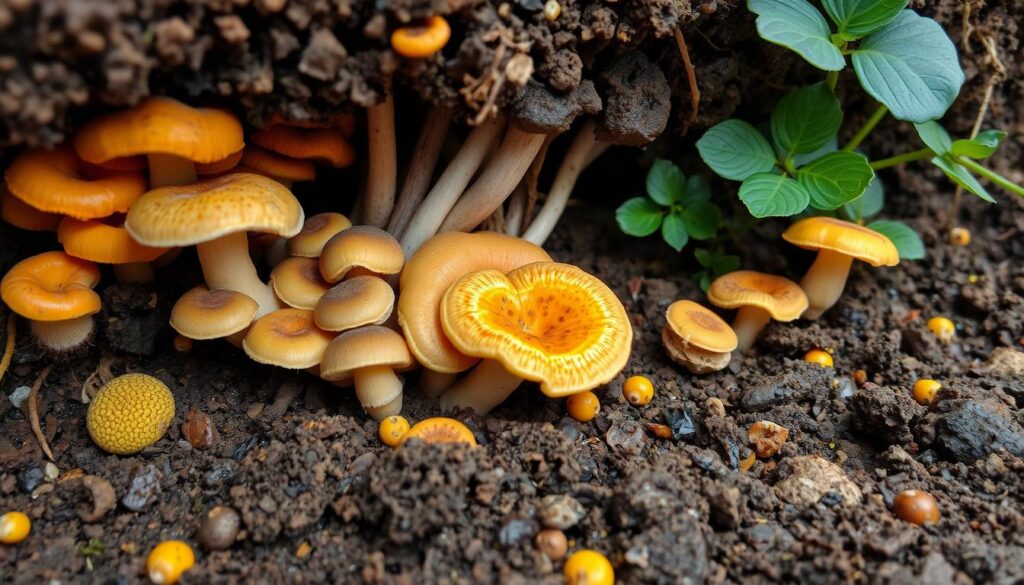
| Mushroom Species | Substrate | Benefits |
|---|---|---|
| Shiitake | Wood chips | Food, medicine, income |
| Oyster | Straw | Food, income, environmental sustainability |
Fungi’s Role in Carbon Sequestration
Fungi are key in storing carbon in soil. They break down organic matter, which is vital for permaculture soil health and fungal diversity in permaculture. Knowing how fungi help soil carbon is crucial for a sustainable permaculture.
Fungal Contribution to Soil Carbon
Fungi can hold up to 36% of yearly carbon emissions in soil. They are essential in the fight against climate change. Fungi as bioindicators in permaculture help us check soil health and find ways to improve it. By boosting fungal growth and diversity, we can store more carbon and fight climate change.
Impacts on Climate Change
Fungi’s role in fighting climate change is huge. Mycorrhizal networks can store 8 times more carbon than non-mycorrhizal plants. Adding fungi to permaculture systems can cut down greenhouse gas emissions. This leads to a more sustainable future.
Integrating Fungi in Permaculture Design
Permaculture design aims to create a sustainable and regenerative ecosystem. Incorporating fungi is key to achieving this goal. They help improve soil health, promote plant growth, and increase biodiversity. Plant guilds are a great way to use fungi, as they form symbiotic relationships with other organisms.
Fungi offer many benefits in permaculture. They can improve soil fertility, structure, and health. For instance, mycorrhizal fungi help plants absorb more nutrients and water. Oyster mushrooms can break down organic matter and recycle nutrients. By using these fungi, we can make our ecosystems more resilient and diverse.
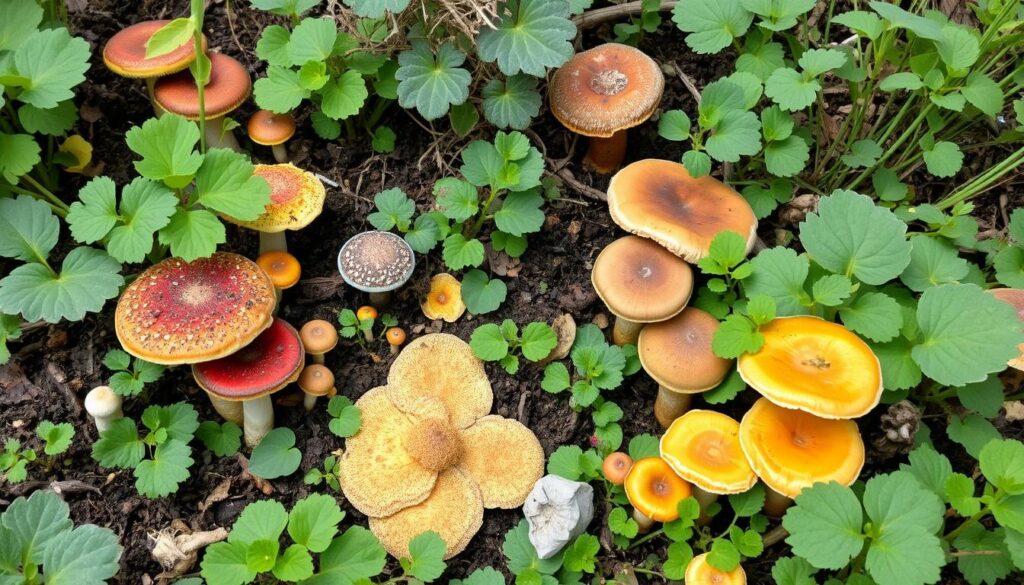
To incorporate fungi in permaculture, we can use fungal inoculants and create habitats for them. Proper soil management also promotes fungal growth. This way, we can enjoy the benefits of permaculture fungi and create a sustainable ecosystem. Some useful fungi include:
- Reishi (Ganoderma lucidum)
- Turkey Tail (Trametes versicolor)
- Oyster mushrooms (Pleurotus ostreatus)
By adding fungi to permaculture design, we adopt a holistic approach to agriculture. This approach focuses on soil health, biodiversity, and ecosystem services. The advantages of using fungi in permaculture are clear. They help us build a sustainable and resilient food system for the future.
Cultivating Fungi in Permaculture Systems
Permaculture mycorrhizal fungi are key to making farming sustainable. They improve soil health and fertility. To grow fungi, it’s important to know how to cultivate them and what practices work best.
Using fungal inoculants is a good way to start. These are added to the soil or substrate to help fungi grow.
Some mushrooms, like oyster mushrooms, can grow on many things. This includes corn stalks, wheat, rice, rye straw, and paper by-products. King Stropharia mushrooms, for example, grow best when it’s between 60-90°F (15-32°C) outside. This matches the soil temperature of 55-65°F (13-18°C).
By making a friendly place for fungi, permaculture farmers help their fungal networks grow. These networks are crucial for sustainable farming.
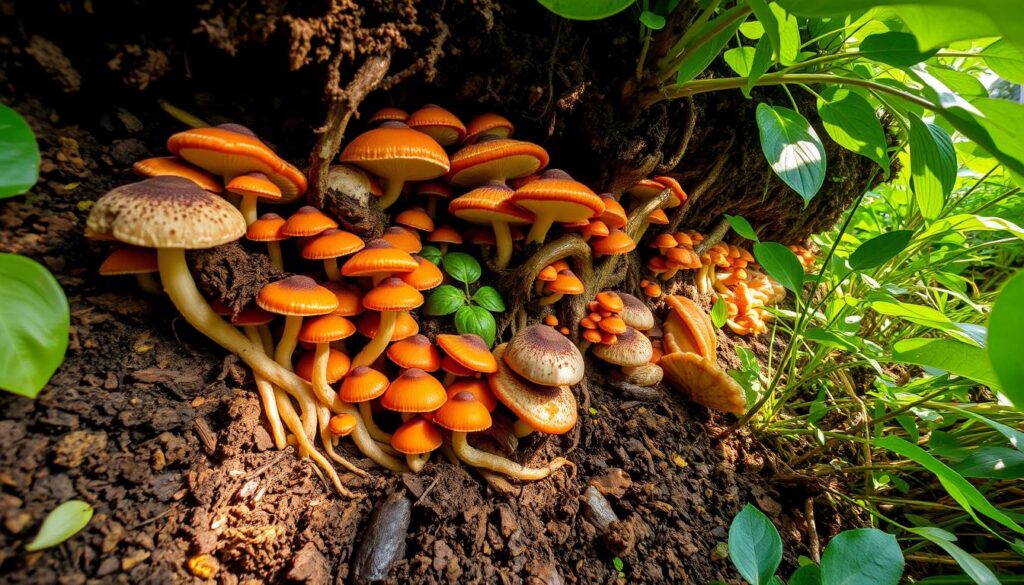
Cultivating fungi in permaculture has many benefits. King Stropharia mushrooms, for instance, can clean water by removing harmful bacteria. They also help reduce nitrogen in water, which is good for the environment.
By adding permaculture mycorrhizal fungi to their farms, farmers make their systems more sustainable and strong.
| Mushroom Species | Substrate | Temperature Range |
|---|---|---|
| Oyster Mushrooms | Corn stalks, wheat, rice, rye straw, paper by-products | 55-65°F (13-18°C) |
| King Stropharia | Straw, wood chips | 60-90°F (15-32°C) |
By following the right steps and using the best substrates and temperatures, farmers can grow fungi. This makes their permaculture systems more sustainable and strong.
Research and Innovations in Fungal Agriculture
Recent studies show how vital permaculture soil health and fungal diversity in permaculture are. Fungi help keep soil fertile and support plant growth. They also act as fungi as bioindicators in permaculture, showing the health of the ecosystem.
Scientists are looking into fungi’s role in farming. They see fungi as potential biofertilizers and pest fighters. For instance, arbuscular mycorrhizal fungi (AMF) help plants absorb more phosphorus, boosting crop yields. Some key discoveries include:
- AMF can connect with 80-90% of all plants on land.
- Using AMF can increase phosphorus uptake by up to 104% compared to plants without it.
- Fungi can break down harmful pollutants with their enzymes and acidic compounds.
These findings underscore the significance of permaculture soil health and fungi as bioindicators in permaculture. By boosting fungal diversity in permaculture, we can build more durable and green farming systems.
| Benefit | Description |
|---|---|
| Improved crop yields | Increased phosphorus uptake through AMF associations |
| Enhanced soil fertility | Promotion of beneficial microbial communities |
| Pest control | Use of fungi as biocontrol agents |
Challenges in Fungal Integration
Adding fungi to permaculture systems can be tricky. Many face a lack of knowledge about permaculture fungal species. It’s key to know these hurdles to build a strong permaculture system. A big worry is that benefits of permaculture fungi might not show up if the soil isn’t right or there’s not enough fungal starter.
To beat these hurdles, we need to help fungi grow well. This means making sure they have the right place to live and food to eat. You can do this by incorporating fungi in permaculture with special habitats and starters. Some ways to do this include:
- Creating a cozy home for fungi by keeping the soil just right in moisture and temperature
- Adding fungal starters to make the soil richer and plants healthier
- Using methods like conservation tillage to keep the soil undisturbed and help fungi thrive
By tackling these challenges and using smart ways to incorporating fungi in permaculture, we can make the most of permaculture fungal species. This way, we can enjoy all the benefits of permaculture fungi in our permaculture systems.
Conclusion
Fungi can greatly improve permaculture systems, making farming more sustainable and strong. They help with soil health, nutrient cycling, and protect plants. This makes permaculture more productive and lasting.
Summary of Key Takeaways
This look at fungi in permaculture shows their big role. They help with soil, nutrients, and plant safety. By using these fungi, farmers can make their land better, use less chemicals, and support more life.
Final Thoughts on Fungal Potential in Permaculture
The world needs better ways to farm, and fungi in permaculture are a key solution. They help plants and ecosystems work together. This approach makes food systems stronger and protects our planet for the future.

